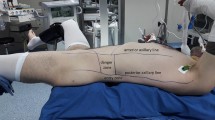Abstract
The downward orientation of the access sheath during supine percutaneous nephrolithotomy (PCNL) allows the faster evacuation of fluids and stone fragments. It theoretically can contribute to the reduction of the high intrarenal pressure-associated complications. We aimed to investigate whether there is a difference between prone and supine PCNL in terms of infective complications. This retrospective study includes 182 patients who underwent supine and prone PCNL due to kidney stones in our clinic between April 2020 and May 2022. Demographic (age, sex, body mass index, comorbidities), radiological (cumulative stone burden, stone density, number of stones, stone localization, stone laterality, presence of hydronephrosis), clinical (previous stone surgery, previous urinary tract) and perioperative (prone or supine position, surgery duration, hospitalization, success, non-infective and infective complications) data of all patients were evaluated. All patients were divided into two groups, the prone position group, and the supine position group. These two groups were compared in terms of pre and postoperative data above. Infective complications were observed in 16 (18%) patients in the prone position group and in 7 (7.5%) patients in the supine position group, and this difference was statistically significant (p = 0.034). Surgery duration (OR = 1.041; 95% CI 1.021–1.061; p < 0.001), number of stones (OR = 4.09; 95% CI 1.093–7.309; p = 0.036), previous urinary tract infection (OR = 6.272; 95% CI 1.936–9.317; p = 0.002) and prone position (OR = 4.511; 95% CI 1.265–7.087; p = 0.02) were found as independent risk factors for infective complications. Prone position was proved as an independent predictor of postoperative infectious events. Supine PCNL will be further adopted as the standard PCNL approach by a continuously growing proportion of endourologists.
Similar content being viewed by others
Data availability
The datasets generated and/or analyzed during the current study are available in Figshare Repository at https://figshare.com/s/3af84b7e0ab28bb890b3.
Code availability
Not applicable.
References
Skolarikos A (Chair), Neisius A, Petřík A, Somani B, Thomas K, Gambaro G (2022) EAU guidelines on urolithiasis. EAU guidelines office, Arnhem, The Netherland
Zeng G, Sarica K (2020) Percutanous nephrolithotomy. Springer, Singapore
Liatsikos E, Tsaturyan A, Kallidonis P (2022) Percutaneous nephrolithotomy for stone disease: which position? Prone position! Eur Urol Open Sci 35:6
Giusti G, Pavia MP, Rico L, Proietti S (2022) Percutaneous nephrolithotomy: which position? Supine position! Eur Urol Open Sci 35:1
Liu L, Zheng S, Xu Y, Wei Q (2010) Systematic review and meta-analysis of percutaneous nephrolithotomy for patients in the supine versus prone position. J Endourol 24(12):1941–1946
Zhang X, Xia L, Xu T, Wang X, Zhong S, Shen Z (2014) Is the supine position superior to the prone position for percutaneous nephrolithotomy (PCNL)? Urolithiasis 42(1):87–93
Kamphuis GM, Baard J, Westendarp M, de la Rosette JJ (2015) Lessons learned from the CROES percutaneous nephrolithotomy global study. World J Urol 33(2):223–233
Al-Dessoukey AA, Moussa AS, Abdelbary AM, Zayed A, Abdallah R, Elderwy AA, Massoud AM, Aly AH (2014) Percutaneous nephrolithotomy in the oblique supine lithotomy position and prone position: a comparative study. J Endourol 28(9):1058–1063
Melo PAdS, Vicentini FC, Perrella R, Murta CB, Claro JFdA (2019) Comparative study of percutaneous nephrolithotomy performed in the traditional prone position and in three different supine positions. Int Braz J Urol 45:108–117
Birowo P, Tendi W, Widyahening IS, Rasyid N, Atmoko W (2020) Supine versus prone position in percutaneous nephrolithotomy: a systematic review and meta-analysis. F1000Research 9:231
Gutierrez J, Smith A, Geavlete P, Shah H, Kural AR, de Sio M, Sesmero JHA, Hoznek A, de la Rosette J, CROES PCNL Study Group (2013) Urinary tract infections and post-operative fever in percutaneous nephrolithotomy. World J Urol 31(5):1135–1140
Rivera M, Viers B, Cockerill P, Agarwal D, Mehta R, Krambeck A (2016) Pre-and postoperative predictors of infection-related complications in patients undergoing percutaneous nephrolithotomy. J Endourol 30(9):982–986
Lai WS, Assimos D (2018) Factors associated with postoperative infection after percutaneous nephrolithotomy. Rev Urol 20(1):7
Jiang E, Guo H, Yang B, Li P, Mishra P, Yang T, Li Y, Wang H, Jiang Y (2020) Predicting and comparing postoperative infections in different stratification following PCNL based on nomograms. Sci Rep 10(1):1–8
Uchida Y, Takazawa R, Kitayama S, Tsujii T (2018) Predictive risk factors for systemic inflammatory response syndrome following ureteroscopic laser lithotripsy. Urolithiasis 46(4):375–381
Falahatkar S, Mokhtari G, Teimoori M (2016) An update on supine versus prone percutaneous nephrolithotomy: a meta-analysis. Urol J 13(5):2814–2822
Falahatkar S, Moghaddam AA, Salehi M, Nikpour S, Esmaili F, Khaki N (2008) Complete supine percutaneous nephrolithotripsy comparison with the prone standard technique. J Endourol 22(11):2513–2518
Valdivia JG, Scarpa RM, Duvdevani M, Gross AJ, Nadler RB, Nutahara K, de la Rosette JJMCH, Croes PCNL Study Group (2011) Supine versus prone position during percutaneous nephrolithotomy: a report from the clinical research office of the endourological society percutaneous nephrolithotomy global study. J Endourol 25(10):1619–1625
Funding
The author(s) received no financial support for the research, authorship.
Author information
Authors and Affiliations
Contributions
Conception and design: YK, SS; Data acquisition: EU; Data analysis and interpretation: SS, MEP; Drafting the manuscript: AK, EU; Critical revision of the manuscript for scientific and factual content: SS, AK; Statistical analysis: SS; Supervision: YK.
Corresponding author
Ethics declarations
Conflict of interest
The authors report no conflicts of interest.
Ethical approval
The present study protocol was reviewed and approved by the Institutional Review Board of ### Hospital (approval number: E2-22-2181).
Consent to participate
Not applicable.
Consent for publication
Not applicable.
Additional information
Publisher's Note
Springer Nature remains neutral with regard to jurisdictional claims in published maps and institutional affiliations.
Rights and permissions
Springer Nature or its licensor holds exclusive rights to this article under a publishing agreement with the author(s) or other rightsholder(s); author self-archiving of the accepted manuscript version of this article is solely governed by the terms of such publishing agreement and applicable law.
About this article
Cite this article
Kasap, Y., Senel, S., Uzun, E. et al. Does surgical position affect infective complications in percutaneous nephrolithotomy?. Urolithiasis 50, 765–771 (2022). https://doi.org/10.1007/s00240-022-01367-6
Received:
Accepted:
Published:
Issue Date:
DOI: https://doi.org/10.1007/s00240-022-01367-6




